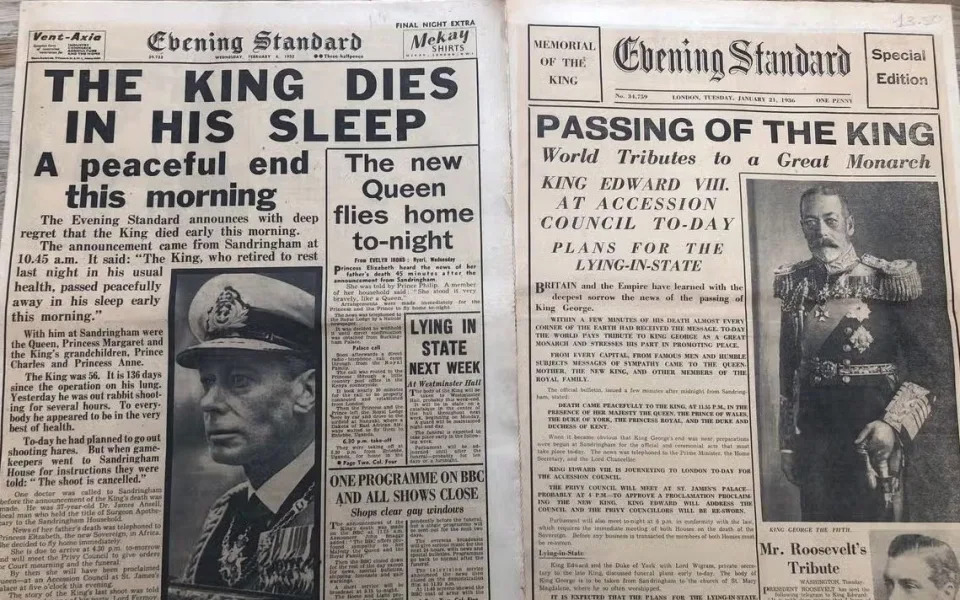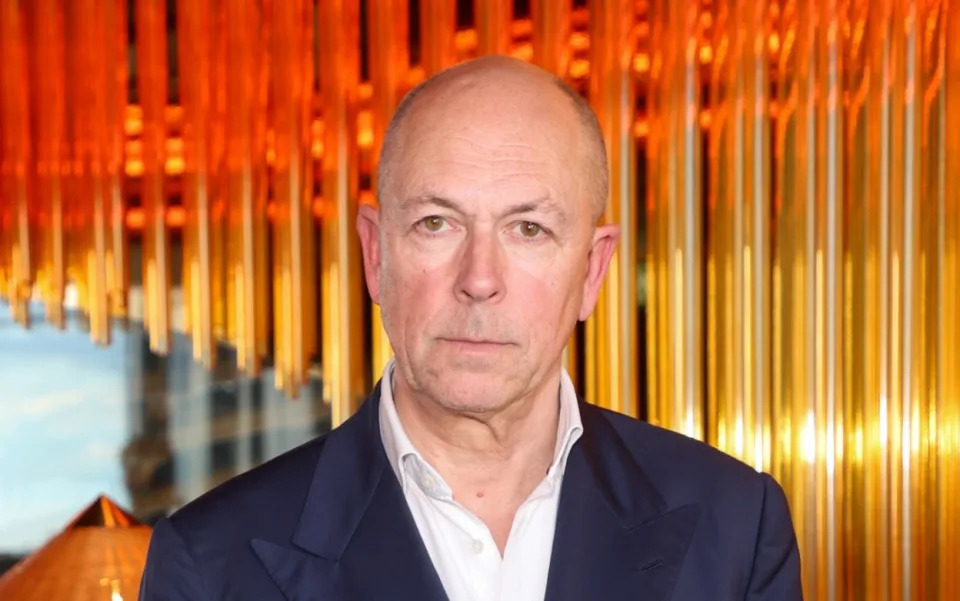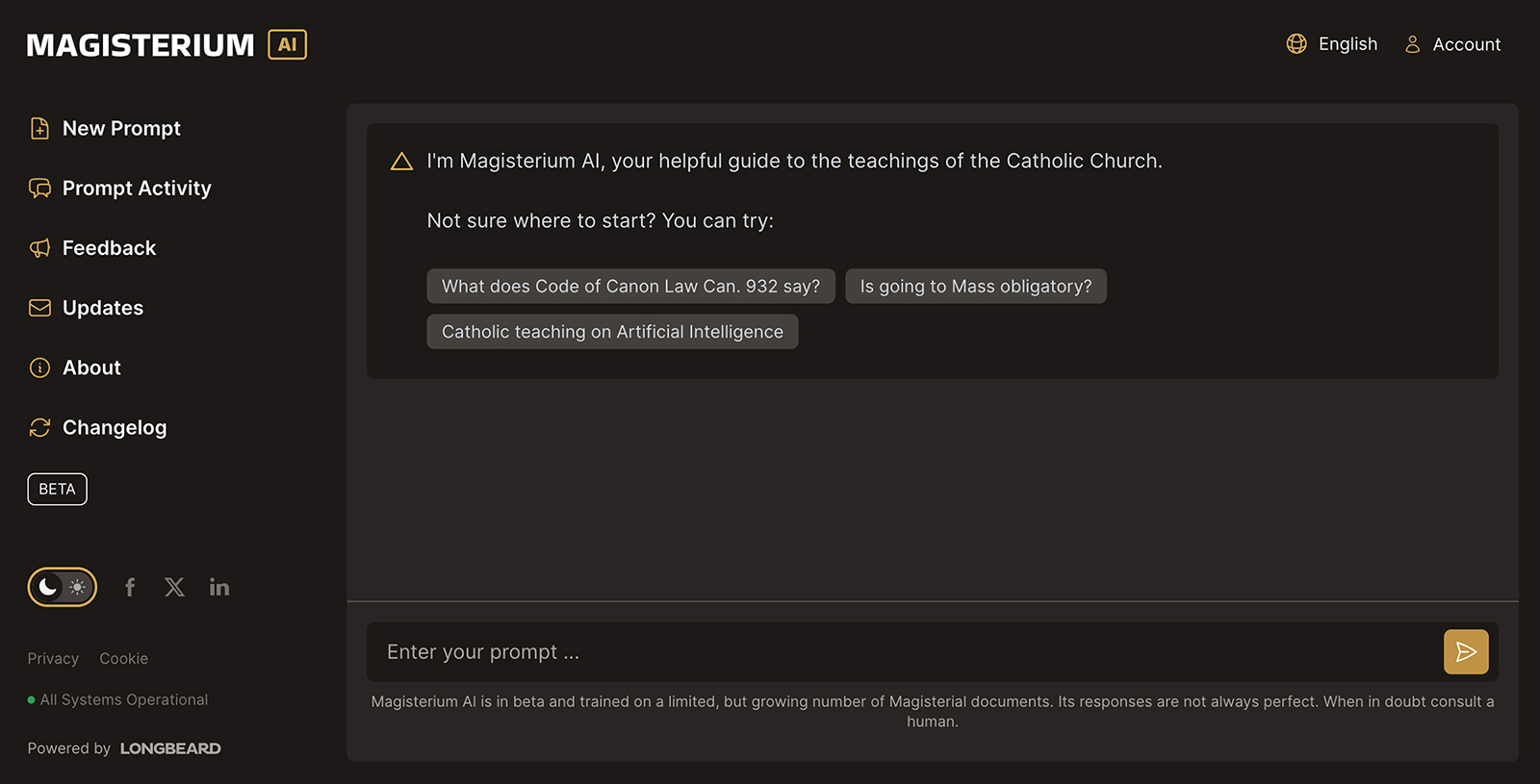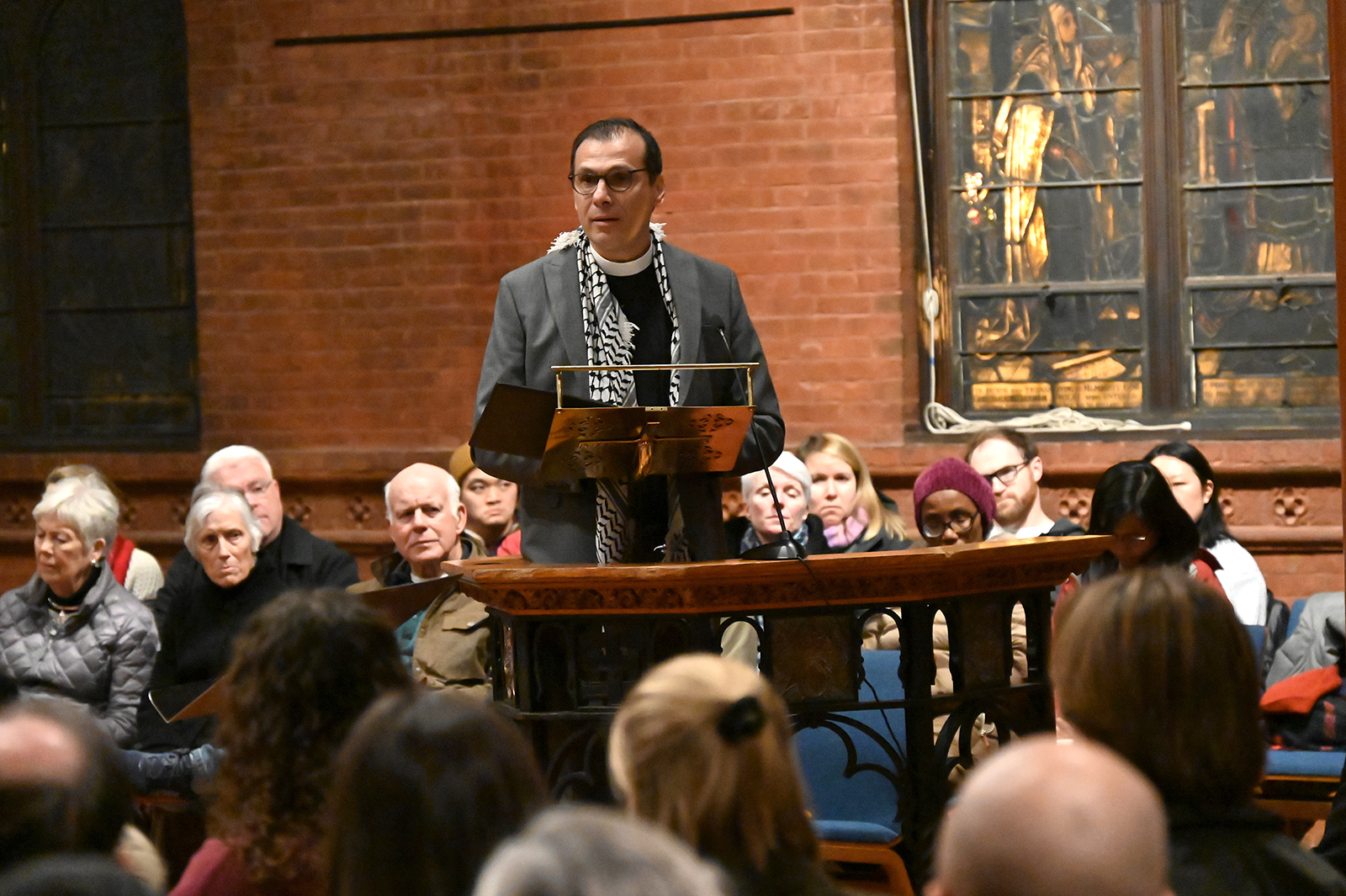1 day ago
Ian Youngs,Culture reporter
BBC
 PA Media
PA Media
The Evening Standard newspaper has announced plans to drop its daily print edition and go weekly.
The London paper launched in its original incarnation in 1827, and became free of charge in 2009.
An email to staff on Wednesday said more home working, and the availability of wi-fi on the Tube, were among the factors that had harmed its fortunes.
It said "a proposed new weekly newspaper would replace the daily publication".
The paper's circulation has dropped from 850,000 to 275,000 in the past five years, and it has lost £84.5m over the latest six years.
There has been speculation about its future for some time.
The paper's forerunner, named the Standard, launched 197 years ago, with an evening version added in 1859.
The Evening Standard was bought by businessman and former Russian intelligence officer Alexander Lebedev and his son Evgeny in 2009.
When they took over, the circulation shot up from about 250,000 after they decided to make it free and rely on income from advertising instead of the cover price.
Despite remaining free, the circulation has dropped to just above 2009 levels.
Last year, Bloomberg reported that new Standard editor Dylan Jones said he took the job on the condition that its owners didn't shut down the print edition.
However, earlier this month he admitted he "never" read a print newspaper, according to the Press Gazette.
The Lebedevs also bought the Independent in 2010, and scrapped that paper's print edition entirely six years later.
Wednesday's email to Standard staff said: "Although, this process may be unsettling, our goal is to replicate our previous success with our sister title, The Independent, which has seen enduring growth in readership and commercial success following its own strategic transition in 2016."
Twelve million people access the Standard's digital platforms every month, with half of that traffic coming from outside London and overseas, it said.
It added that a "new commercial approach would reinforce the relationship between our 24/7 digital platforms and our weekly publication.
"This new combination would place more emphasis on delivering our world-class content to the broadest readership possible, while collaborating with advertisers to reach this audience in the most accessible, creative, and relevant manner."
The company has not given details of any job losses.
Evening Standard to drop daily edition in favour of weekly newspaper
 PA Media
PA MediaThe Evening Standard newspaper has announced plans to drop its daily print edition and go weekly.
The London paper launched in its original incarnation in 1827, and became free of charge in 2009.
An email to staff on Wednesday said more home working, and the availability of wi-fi on the Tube, were among the factors that had harmed its fortunes.
It said "a proposed new weekly newspaper would replace the daily publication".
The paper's circulation has dropped from 850,000 to 275,000 in the past five years, and it has lost £84.5m over the latest six years.
There has been speculation about its future for some time.
The paper's forerunner, named the Standard, launched 197 years ago, with an evening version added in 1859.
The Evening Standard was bought by businessman and former Russian intelligence officer Alexander Lebedev and his son Evgeny in 2009.
When they took over, the circulation shot up from about 250,000 after they decided to make it free and rely on income from advertising instead of the cover price.
Despite remaining free, the circulation has dropped to just above 2009 levels.
Last year, Bloomberg reported that new Standard editor Dylan Jones said he took the job on the condition that its owners didn't shut down the print edition.
However, earlier this month he admitted he "never" read a print newspaper, according to the Press Gazette.
The Lebedevs also bought the Independent in 2010, and scrapped that paper's print edition entirely six years later.
Wednesday's email to Standard staff said: "Although, this process may be unsettling, our goal is to replicate our previous success with our sister title, The Independent, which has seen enduring growth in readership and commercial success following its own strategic transition in 2016."
Twelve million people access the Standard's digital platforms every month, with half of that traffic coming from outside London and overseas, it said.
It added that a "new commercial approach would reinforce the relationship between our 24/7 digital platforms and our weekly publication.
"This new combination would place more emphasis on delivering our world-class content to the broadest readership possible, while collaborating with advertisers to reach this audience in the most accessible, creative, and relevant manner."
The company has not given details of any job losses.
Evening Standard to drop daily edition in favour of weekly newspaper
Anna Wise, PA Business Reporter
Wed, May 29, 2024

London’s Evening Standard newspaper is set to scrap its daily editions in favour of a weekly publication.
The newspaper is currently circulated free of charge at the capital’s Underground stations from Monday to Friday.
But in a memo sent to staff and seen by the PA news agency, the company said it has been making “substantial losses” with its current operation, which has prompted the need for a change of direction.
Fewer commuters travelling through London following the pandemic, changing consumer behaviours, and the introduction of wifi on parts of the London Underground have all affected the newspaper, it said.
“Therefore, we plan to consult with our staff and external stakeholders to reshape the business, return to profitability and secure the long-term future of the number one news brand in London,” the email read.
The same memo, sent by the Evening Standard’s chairman, Paul Kanareck, proposed introducing a weekly newspaper to replace the daily publication.
This would be shaped by more in-depth analysis and relevant lifestyle, sports and culture guides and news.
The business said it needs to “change with the times”, but switching to a weekly publication means it can retain its printed newspaper in an increasingly digital world.
“Although this process may be unsettling, our goal is to replicate our previous success with our sister title, The Independent, which has seen enduring growth in readership and commercial success following its own strategic transition in 2016,” Mr Kanareck wrote.
The Evening Standard said that it was currently in consultation with its staff following the announcement.
It did not give details about any potential job reductions, but said the number of employees going forward will partly depend on its discussions with staff, and as it hones in on its digital platforms.
The Evening Standard is owned by Evgeny Lebedev, who is also a shareholder in The Independent and the son of oligarch Alexander Lebedev.
He was appointed to the House of Lords in November 2020.
Rival publisher Reach, which owns the Daily Mirror and the Express newspapers, earlier this year revealed plans to cut costs and reduce jobs as part of efforts to boost its online presence.
It said it needed to evolve to meet an “increasingly fast-paced, competitive and customer-focused digital world”.
Evening Standard scraps daily print paper as it blames work from home
James Warrington
TELEGRAPH
Wed, May 29, 2024

The Standard was founded in 1827 but has been struggling for direction in recent years - HOLLIE ADAMS/AFP via Getty Images
The Evening Standard is to stop printing a daily newspaper, blaming working from home and increased wifi on the London Underground.
The London freesheet told staff on Wednesday it will scrap its daily print edition and become a weekly title instead.
The future of the glossy ES Magazine, which currently comes out once a week, has also been thrown into doubt with executives saying they will consult on reducing the frequency of its publication.
Bosses said the plans and any impact on staff levels would be subject to a consultation, sparking fears of job losses.
In a memo, seen by The Telegraph, the Standard said its current losses were not sustainable and that it would now “reshape the business” to secure its long-term future.
Bosses told staff: “In this process, we will consult on the launch of a brand-new weekly newspaper later this year and consider options for retaining ES Magazine with reduced frequency.
“A proposed new weekly newspaper would replace the daily publication, allowing for more in-depth analysis of the issues that matter to Londoners, and serve them in a new and relevant way by celebrating the best London has to offer, from entertainment guides to lifestyle, sports, culture and news and the drumbeat of life in the world’s greatest city.”

Owner Lord Lebedev has pumped loans of at least £29m into the newspaper over the last two years - Justin Tallis/AFP
The Standard, which is owned by Russian-born billionaire Lord Lebedev, has been struggling for direction in recent years after being hammered by a collapse in commuting and a deep advertising downturn during Covid lockdowns.
The rise of home working and increased mobile and wifi signal on the London Underground have also hit its readership.
In October, print circulation dropped below 300,000 for the first time since it became a free newspaper in 2009. Its circulation peaked at more than 900,000 in 2016.
Surging inflation and print costs have also hurt the publication’s bottom line. The paper has shrunk to an average of around 30 pages, down from roughly 70 a decade ago.
Bosses have attempted to diversify the company away from advertising by pushing into sponsored content and live events.
The company says it has a monthly UK audience of 12 million people, with over half its total traffic coming from outside London and overseas. However, ad sales still make up the vast majority of its revenues.

The Standard has been a fixture on the streets of London for nearly 200 years
Lord Lebedev has been forced to pump loans of at least £29m into the newspaper over the last two years, while losses ballooned to £16.4m in 2022.
The freesheet has acknowledged it requires additional funding to stay afloat, which the peer last year agreed to provide for a further 12 months.
Lord Lebedev, who bought the Standard in 2009 for just £1, has raised eyebrows by using the title to wage a freedom of speech campaign, penning a number of articles railing against cancel culture.
The Standard, which was founded in 1827, has also been rocked by turmoil in its senior management in recent months.
The media group is still without a chief executive after the abrupt departure of Charles Yardley, who left last summer after three years. Rich Mead took up the role on an interim basis but also stepped down in November.
The newspaper’s editorial direction has also come under scrutiny. Lord Lebedev last year brought in Dylan Jones, the former editor of men’s magazine GQ, as editor-in-chief.

Former GQ editor Dylan Jones was brought in to replace Emily Sheffield as the paper's editor-in-chief last year - Dave Benett/Getty Images
Mr Jones, a well-known journalist and socialite who helped David Cameron write his 2008 biography, filled a lengthy vacuum at the top of the paper after Emily Sheffield, Lord Cameron’s sister-in-law, stepped down as editor in 2021 after just 15 months in the role.
Under his tenure, the newspaper has hired a number of high-profile columnists including artist Tracey Emin and American journalist Michael Wolff.
Meanwhile, Lord Lebedev has become an increasingly controversial figure in the wake of Russia’s invasion of Ukraine.
The billionaire, who also co-owns the Independent, was nominated for a peerage in 2020 by then-prime minister Boris Johnson, a long standing friend.
The move triggered outrage – and later national security concerns – when Lord Lebedev’s father Alexander, a former KGB agent, was sanctioned by Canada.
Lord Lebedev has insisted he has no links to the Kremlin and penned an article for the Evening Standard early on in the war calling for Vladimir Putin to stop his assault on Ukraine.
The Evening Standard has been contacted for comment.
Wed, May 29, 2024

The Standard was founded in 1827 but has been struggling for direction in recent years - HOLLIE ADAMS/AFP via Getty Images
The Evening Standard is to stop printing a daily newspaper, blaming working from home and increased wifi on the London Underground.
The London freesheet told staff on Wednesday it will scrap its daily print edition and become a weekly title instead.
The future of the glossy ES Magazine, which currently comes out once a week, has also been thrown into doubt with executives saying they will consult on reducing the frequency of its publication.
Bosses said the plans and any impact on staff levels would be subject to a consultation, sparking fears of job losses.
In a memo, seen by The Telegraph, the Standard said its current losses were not sustainable and that it would now “reshape the business” to secure its long-term future.
Bosses told staff: “In this process, we will consult on the launch of a brand-new weekly newspaper later this year and consider options for retaining ES Magazine with reduced frequency.
“A proposed new weekly newspaper would replace the daily publication, allowing for more in-depth analysis of the issues that matter to Londoners, and serve them in a new and relevant way by celebrating the best London has to offer, from entertainment guides to lifestyle, sports, culture and news and the drumbeat of life in the world’s greatest city.”

Owner Lord Lebedev has pumped loans of at least £29m into the newspaper over the last two years - Justin Tallis/AFP
The Standard, which is owned by Russian-born billionaire Lord Lebedev, has been struggling for direction in recent years after being hammered by a collapse in commuting and a deep advertising downturn during Covid lockdowns.
The rise of home working and increased mobile and wifi signal on the London Underground have also hit its readership.
In October, print circulation dropped below 300,000 for the first time since it became a free newspaper in 2009. Its circulation peaked at more than 900,000 in 2016.
Surging inflation and print costs have also hurt the publication’s bottom line. The paper has shrunk to an average of around 30 pages, down from roughly 70 a decade ago.
Bosses have attempted to diversify the company away from advertising by pushing into sponsored content and live events.
The company says it has a monthly UK audience of 12 million people, with over half its total traffic coming from outside London and overseas. However, ad sales still make up the vast majority of its revenues.

The Standard has been a fixture on the streets of London for nearly 200 years
Lord Lebedev has been forced to pump loans of at least £29m into the newspaper over the last two years, while losses ballooned to £16.4m in 2022.
The freesheet has acknowledged it requires additional funding to stay afloat, which the peer last year agreed to provide for a further 12 months.
Lord Lebedev, who bought the Standard in 2009 for just £1, has raised eyebrows by using the title to wage a freedom of speech campaign, penning a number of articles railing against cancel culture.
The Standard, which was founded in 1827, has also been rocked by turmoil in its senior management in recent months.
The media group is still without a chief executive after the abrupt departure of Charles Yardley, who left last summer after three years. Rich Mead took up the role on an interim basis but also stepped down in November.
The newspaper’s editorial direction has also come under scrutiny. Lord Lebedev last year brought in Dylan Jones, the former editor of men’s magazine GQ, as editor-in-chief.

Former GQ editor Dylan Jones was brought in to replace Emily Sheffield as the paper's editor-in-chief last year - Dave Benett/Getty Images
Mr Jones, a well-known journalist and socialite who helped David Cameron write his 2008 biography, filled a lengthy vacuum at the top of the paper after Emily Sheffield, Lord Cameron’s sister-in-law, stepped down as editor in 2021 after just 15 months in the role.
Under his tenure, the newspaper has hired a number of high-profile columnists including artist Tracey Emin and American journalist Michael Wolff.
Meanwhile, Lord Lebedev has become an increasingly controversial figure in the wake of Russia’s invasion of Ukraine.
The billionaire, who also co-owns the Independent, was nominated for a peerage in 2020 by then-prime minister Boris Johnson, a long standing friend.
The move triggered outrage – and later national security concerns – when Lord Lebedev’s father Alexander, a former KGB agent, was sanctioned by Canada.
Lord Lebedev has insisted he has no links to the Kremlin and penned an article for the Evening Standard early on in the war calling for Vladimir Putin to stop his assault on Ukraine.
The Evening Standard has been contacted for comment.
The Evening Standard Plans to Scrap Daily Print Edition Due to Substantial Losses
Tianwei Zhang
WWD
Wed, May 29, 2024

LONDON — British newspaper The Evening Standard — a staple in many London commuters’ daily routines — said Wednesday that it plans to axe its loss-making daily print edition.
Instead it plans to launch a weekly edition later in the year to replace the daily publication, “allowing for more in-depth analysis of the issues that matter to Londoners, and serve them in a new and relevant way by celebrating the best London has to offer, from entertainment guides to lifestyle, sports, culture and news and the drumbeat of life in the world’s greatest city,” said Paul Kanareck, the newspaper’s chair, in a memo sent to staff.
ES Magazine, the weekly fashion, culture and lifestyle supplement of the newspaper under the supervision of Ben Cobb, may be retained with reduced frequency, added Kanareck.
Following the rise of home working post-pandemic and the arrival of free Wi-Fi and 5G connection in most central London tube stations by the end of 2024, the paper’s print circulation dropped below 300,000 last year for the first time since it became a free newspaper in 2009, after being purchased for a nominal 1 pound by Russian businessman and former KGB agent Alexander Lebedev.
Kanareck added that the newspaper’s substantial losses — 84.5 million pounds, or $107 million, in the past six years — are not sustainable.
“We plan to consult with our staff and external stakeholders to reshape the business, return to profitability, and secure the long-term future of the number-one news brand in London,” he said.
The newspaper said more than 12 million people access its digital platforms every month, with more than half of them traveling in and out of London.
The top management wants the 197-year-old The Evening Standard to adopt a similar digital transformation its sister publication The Independent, which was acquired by Lebedev in 2010, went through six years ago.
“Although this process may be unsettling, our goal is to replicate our previous success with our sister title, The Independent, which has seen enduring growth in readership and commercial success following its own strategic transition in 2016,” Kanareck said.
He added that a “new commercial approach would reinforce the relationship between our 24/7 digital platforms and our weekly publication.”
“This new combination would place more emphasis on delivering our world-class content to the broadest readership possible, while collaborating with advertisers to reach this audience in the most accessible, creative and relevant manner.”
It’s not clear how many jobs will be impacted from journalists and designers working for the print edition to distributors who hand out the newspaper across London daily.
A separate email from the Evening Standard HR team told staff that “at this stage, [we] do not yet know the exact impact of the changes” and said the business is pre-emptively seeking “to put in place a sound consultation structure for when further details are announced.”
Decision to end Evening Standard's daily edition is heartbreaking but its history proves the power of news
Wed, May 29, 2024

LONDON — British newspaper The Evening Standard — a staple in many London commuters’ daily routines — said Wednesday that it plans to axe its loss-making daily print edition.
Instead it plans to launch a weekly edition later in the year to replace the daily publication, “allowing for more in-depth analysis of the issues that matter to Londoners, and serve them in a new and relevant way by celebrating the best London has to offer, from entertainment guides to lifestyle, sports, culture and news and the drumbeat of life in the world’s greatest city,” said Paul Kanareck, the newspaper’s chair, in a memo sent to staff.
ES Magazine, the weekly fashion, culture and lifestyle supplement of the newspaper under the supervision of Ben Cobb, may be retained with reduced frequency, added Kanareck.
Following the rise of home working post-pandemic and the arrival of free Wi-Fi and 5G connection in most central London tube stations by the end of 2024, the paper’s print circulation dropped below 300,000 last year for the first time since it became a free newspaper in 2009, after being purchased for a nominal 1 pound by Russian businessman and former KGB agent Alexander Lebedev.
Kanareck added that the newspaper’s substantial losses — 84.5 million pounds, or $107 million, in the past six years — are not sustainable.
“We plan to consult with our staff and external stakeholders to reshape the business, return to profitability, and secure the long-term future of the number-one news brand in London,” he said.
The newspaper said more than 12 million people access its digital platforms every month, with more than half of them traveling in and out of London.
The top management wants the 197-year-old The Evening Standard to adopt a similar digital transformation its sister publication The Independent, which was acquired by Lebedev in 2010, went through six years ago.
“Although this process may be unsettling, our goal is to replicate our previous success with our sister title, The Independent, which has seen enduring growth in readership and commercial success following its own strategic transition in 2016,” Kanareck said.
He added that a “new commercial approach would reinforce the relationship between our 24/7 digital platforms and our weekly publication.”
“This new combination would place more emphasis on delivering our world-class content to the broadest readership possible, while collaborating with advertisers to reach this audience in the most accessible, creative and relevant manner.”
It’s not clear how many jobs will be impacted from journalists and designers working for the print edition to distributors who hand out the newspaper across London daily.
A separate email from the Evening Standard HR team told staff that “at this stage, [we] do not yet know the exact impact of the changes” and said the business is pre-emptively seeking “to put in place a sound consultation structure for when further details are announced.”
Decision to end Evening Standard's daily edition is heartbreaking but its history proves the power of news
Sky News
Wed, May 29, 2024

For anyone who cares about newspapers, the announcement that London's Evening Standard is to close its daily print edition and replace it with a weekly freesheet is heartbreaking - and not just because half of the editorial staff look set to lose their jobs.
People outside London may not care very much.
But this supposed regional title punches well above its weight and, to this day, influences what they read.
Money latest:
Man Utd staff 'given week to resign' in WFH crackdown
People think the term 'rolling news' only applies to TV channels like Sky News.
At the height of its powers, though, the Standard published six editions daily - including the Metro and News Extra editions in the morning, the City Prices edition at lunchtime and the West End Final edition in the evening.
It is no exaggeration to say that by publishing so many editions - the title dropped to a single edition at the end of 2009 - the Standard would set the news agenda, whether that was in Westminster, the Square Mile or elsewhere.
That era was brought to mind in the recent obituaries of Charles Reiss, the Standard's political editor from 1985-2004, which served to remind how the Standard's take on a big story would be the one that, frequently, informed how Fleet Street would cover it the following morning.
In the pre-internet age, Reiss was, for example, the first newspaperman to report to readers that Margaret Thatcher was set to resign as prime minister.
His exclusive in September 2002, headlined '45 minutes from attack', also set the tone for the national coverage as then prime minister Tony Blair prepared to take the country to war in Iraq.
Influential in the world of business and beyond
The Standard was no less influential with its coverage of business and the City.
Financial public relations executives would make a point of ensuring that Standard journalists got to speak with company chief executives on the day of a major announcement and probably fretted over that particular meeting or phone call more than any other.
They knew that the Standard's coverage was likely to influence that of every other Fleet Street business desk and especially if Anthony Hilton, one of the most influential City editors of the last 40 years, were to pen something particularly acerbic.
It was not just in the fields of politics and finance where the Standard carried weight.
It also applied to fields like the arts and entertainment. The Evening Standard Theatre Awards, launched in 1955, are the UK theatre industry's longest-running awards and retain huge influence and prestige.
Read more Ian King analysis - on Thames Water:
Neither Starmer nor Sunak want to face most likely option
Angering dictators and shaping the national conversation
While the title had built a reputation in the 19th century for covering conflicts such as the American Civil War, it was the 1930s and 1940s when the national influence of the Standard - whose daily edition closes just three years before it was due to celebrate its 200th anniversary - was probably forged.
Banned by Benito Mussolini in 1936, for a cartoon by the legendary David Low that incurred the Italian dictator's wrath, in 1940 it published a series of thundering editorials by the future Labour Party leader Michael Foot - who became the Standard's editor in 1942 - that savaged the slow pace of re-armament in the 1930s in the face of Hitler's aggression.
It shaped the national conversation.
More than 80 years on, the reputations of former prime ministers such as Ramsay MacDonald, Stanley Baldwin and Neville Chamberlain have yet to recover.
A home for great writers
It has also long enjoyed a reputation for classy writing.
The Standard was the title, for example, for which the novelist George Orwell penned his famous 1946 essay 'The Moon Under Water' in which he described his perfect pub - which years later influenced the entrepreneur Tim Martin as he launched his JD Wetherspoon pub chain.
Other great writers who have graced its pages down the years include John Betjeman and Harold Nicolson.
The Standard was also where a number of future editors of national titles - among them Sir Simon Jenkins, Geordie Greig, Stewart Steven and, arguably the greatest of them all, Paul Dacre - built their reputations.
Its influence and prestige were such that it could attract someone of the calibre of Sir Max Hastings to the editor's chair when he left the Daily Telegraph.
Incredibly profitable
It is not that long ago that the Standard was incredibly profitable.
Those profits were defended when, for example, Robert Maxwell sought in 1987 to encroach on its turf with the London Daily News, recruiting journalists such as Alan Rusbridger, the future editor of the Guardian.
The Standard's then owners, Associated Newspapers, responded by exhuming the long-dead Evening News and selling it for just 5p-a-copy - half the price of Maxwell's title. When Maxwell was forced to close the London Daily News, five months later, the Evening News was quietly reburied.
A similar tactic was deployed when, in September 2006, Rupert Murdoch's News International launched the London Paper, a colour freesheet aimed at attracting younger readers for whom the Standard was too right-wing.
Associated responded with a freesheet of its own, London Lite, whose content was mainly drawn from the Standard. Both London Lite and the London Paper were closed in 2009.
The rise of online news
Like all newspaper titles, though, the Standard has found its profitability weakened and then eliminated by the rise of online news.
The title has responded in various ways to this. For example, dropping to a single edition and, in October 2009, becoming a freesheet.
By then, the title was owned by the Russian-born businessman Evgeny Lebedev, whose stewardship of the title is blamed by numerous Standard journalists, past and present, for its demise.
His purchase of the Independent and Independent on Sunday in 2010, and the merger of editorial desks of those titles with those of the Standard, was seen as particularly damaging to the latter.
As unpopular with Standard journalists was his frequent use of the Standard's pages to promote his pet causes and, frequently, himself.
There was also discontent when, shortly after he bought the title, the Standard launched an advertising campaign in which it apologised to younger Londoners, in particular, for being out-of-touch with their views - a key reason News International had launched the London Paper.
Standard journalists saw the campaign as denigrating their work. Ironically, the paper was still making similar mistakes years later, such as backing the unpopular Zac Goldsmith and later, Shaun Bailey, in London mayoral elections.
In fairness to Lebedev, his willingness to bear losses probably kept the title alive for longer than might otherwise have been the case.
Since he acquired it, the Standard has only been profitable for four years, from 2013 to 2016.
Those losses spiralled when, in 2020, most people were prevented from commuting to London by the COVID-19 lockdowns and forced it to resort to home delivery.
Read more from Sky News:
'Czech Sphinx' set to take over Royal Mail
Labour extends lead over Tories - exclusive poll
A well-trodden path to online only
Those losses have now forced the Standard down the path announced today. Even that may not be enough.
Time Out, for decades London's leading weekly 'what's on?' magazine, went free in 2012 but was forced to go online-only in 2022.
The Standard's management told employees today that going online-only in 2016 had helped the Independent to trade profitably and that this was the aspiration for the Standard.
Many newspapers have turned going online to their advantage.
Launching a paywall and subscription services have helped titles that have at times in the recent past been loss-making, like The Times and Daily Telegraph, consistently turn a profit.
Print still packing a punch
But it is instructive that, even as print circulations drift and online audiences grow, Fleet Street's print editions still pack an enormous punch.
The current election campaign has seen eye-catching announcements made by the parties not at 10pm, for the main evening TV bulletins, but at 10.30pm for the Fleet Street print deadlines. The print format retains its power.
It is probably why, even as the vast majority of its output heads online, the Standard is looking to retain the format at least once a week.



























